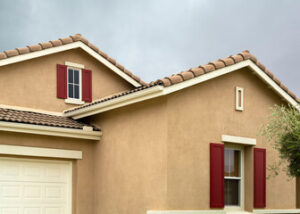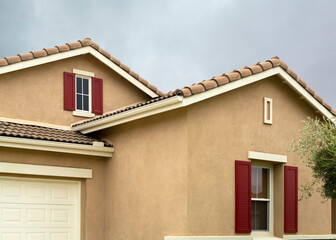Stucco is a long-lasting siding material that offers many design finishes for your home. It is made from Portland cement, sand, and water and can incorporate fiberglass or acrylic additives for added strength.
However, stucco isn’t ideal for all climates – extremely damp areas and rocky regions are not good matches since they can cause foundation shifts. Stucco is also brittle and not flexible, making it susceptible to moisture damage over time. Read on Charleston Advanced Siding Repair to learn more.
Stucco is a very versatile material that can be used to achieve a number of different visual effects for your exterior walls. It can be pigmented in various colors to match your preferred aesthetic and architectural style, and it can also be paired with other materials such as stone or brick accents to further enhance the appearance of your home.
When properly constructed, stucco can be used to create a beautiful and unique look for your exterior that will stand out in any neighborhood. Its timeless elegance can add sophistication and curb appeal to your property, making it a popular choice for homeowners who want to increase the value of their home.
Due to its durability and energy efficiency, stucco is an excellent choice for homes in a variety of climates. It is resistant to water damage, and it can resist the formation of mold and mildew. Additionally, it is highly insulating and can help keep interior temperatures stable and comfortable.
If your home has stucco siding, you should be careful to keep it well-maintained to avoid moisture issues. It is important to regularly clean your stucco with a pressure washer or hose. In addition, you should be careful to use only mild cleaning products, as some harsher cleaners can cause damage to the surface of your stucco. It is also recommended that you keep soil levels high around your house to prevent it from drawing moisture from the ground underneath the stucco.
Stucco is a durable material that will last for decades when properly maintained. It can withstand a variety of weather conditions, including heavy rains and strong winds. It is also highly resistant to impact, and it can withstand the force of flying debris without cracking or chipping.
While stucco has a long history of use in art and building construction, it is gaining popularity as a residential siding option. Its versatility, durability, and low maintenance requirements make it a great choice for homeowners who want to enhance the beauty and value of their home. In addition, it can be paired with other materials to create a unique and eye-catching design that will stand out in any neighborhood.
Durability
Stucco is a cement-based material that has been in use for centuries. It is a versatile building material that can be used to achieve a variety of aesthetic goals. It consists of a mix of Portland cement, sand, and water. More modern stucco also has additives that increase its durability and flexibility. Stucco is very durable, and it can withstand extreme heat and fires. In addition, it is resistant to mold and rot. It can also be tinted in a variety of colors. It can be installed over a variety of materials, including wood and metal.
Like most other siding materials, stucco requires regular maintenance to keep it looking good. Most homeowners should inspect the exterior of their home once a year and make sure that small hairline cracks are not forming. If they do, these should be repaired immediately. If the cracks are not repaired, they can cause lasting damage to the building’s structure.
In addition to its durability, stucco also provides excellent insulation for your home. It keeps warm air from escaping the house during the winter and cold blustery winds from entering during the summer. This can lower your energy bills and keep your home more comfortable all year round.
While stucco is a great choice for most climates, it may not be the best choice for extremely damp areas. Moisture can transfer through the stucco, causing problems with the underlying wood and other structures of the house. In these situations, other siding options might be a better choice.
Concrete is another common composite building material that can be used for a number of different purposes, including making patios and driveways, pouring house foundations, and even creating walls and skyscrapers. Concrete is a highly durable material that can withstand heavy loads and extreme weather conditions. It is also resistant to rot, mildew, and mold. It can be tinted in a wide range of colors and has a natural stone look.
While concrete is very durable, it can be susceptible to cracking if the ground beneath it shifts. This is why it is not a good choice for older houses that are often subject to ground movement.
Low Maintenance
Stucco is a durable material, and it requires minimal maintenance to keep it looking beautiful. It resists fire, rot, mold, and insect damage for up to 100 years. Stucco is also an energy efficient option for your home, keeping the cold out in winter and the hot out in summer. It is a great choice for homeowners who are concerned about environmental issues, such as global warming.
A homeowner’s primary maintenance responsibility for stucco siding is a yearly inspection and cleaning. The inspection should focus on identifying small hairline cracks in the stucco. These should be repaired as soon as possible to prevent further damage. The inspection should also include a thorough cleaning, including a pressure wash to remove dirt buildup and staining. Stucco is an excellent choice for homes with a variety of architectural styles, as it can be applied in multiple different ways.
The material can be used to achieve a rustic, contemporary, or even traditional style. It can be textured, stamped, or carved to match the desired look of the property. In addition, it can be covered with decorative elements, such as flowers, vines, and other flora to create the desired aesthetic.
Unlike other materials, such as vinyl, stucco does not need frequent repainting. Its color is pigmented during the initial application, which makes it resistant to weather damage and other environmental threats that require frequent repainting of other siding materials.
Although it is very durable, stucco is not the best material for certain environments. In very damp locations, it is prone to moisture intrusion and rotting. The material may also be too vulnerable to impact damage, especially if it is not properly protected from wind and rain.
If you love the look of stucco but are concerned about its durability, you may want to consider James Hardie fiber cement siding instead. This material looks similar to stucco, but it is far more resistant to moisture damage and rot. It is also more tolerant of impact damage than other siding options. It is an ideal solution for homeowners who value longevity and low maintenance but still desire the beauty of stucco.
Aesthetics
Stucco siding can add visual interest and intrigue to the exterior of your home. It can complement other materials, such as wood and stone, while still bringing its own unique style. It can also serve as an accent wall, creating a striking contrast to other elements in your home. Whether you opt for a smooth texture or a more textured finish, stucco can be pigmented in various colors to fit any design aesthetic.
Known for its versatility and beauty, stucco has been used in building construction since the renaissance era. Made from a combination of cement, sand, water and lime, it is durable and weather resistant. It can be used to create a variety of textures, ranging from smooth surfaces to intricate patterns, swirls and pebbling.
In addition to its visual appeal, stucco is also an energy efficient material. Its thick composition helps to regulate the temperature inside your home, keeping it cooler in summer and warmer in winter. This can help reduce your energy bills and keep you more comfortable throughout the year.
Unlike other types of siding, stucco can be designed with a wide range of textures and finishes. This makes it easy to achieve a look that fits your individual taste and style. For example, a smooth stucco can be used on a modern home to provide a clean and simple look. While a more textured finish can be used on a southwestern-style ranch house to add warmth and intrigue.
The process of installing stucco siding is relatively simple. First, workers will prepare the work site by laying out tarps to contain debris and erecting scaffolding where necessary. Once the worksite is ready, they will use a hammer to create a small hole in the stucco. Then, they will remove any loosened pieces with a chisel or hammer. Once the hole is cleared, they will apply a small amount of bonding agent to ensure the surface is ready for application.
Lastly, the stucco will be applied using a finishing trowel. This process is what gives the stucco its signature smooth texture. The final product can be painted, but many experts recommend against it. When painted, moisture will pass through the stucco, and can cause rot to the internal home structures.
